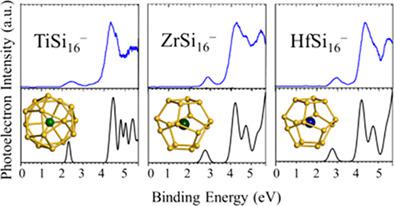当前位置:
X-MOL 学术
›
J. Comput. Chem.
›
论文详情
Our official English website, www.x-mol.net, welcomes your
feedback! (Note: you will need to create a separate account there.)
Revisit of large-gap Si16 clusters encapsulating group-IV metal atoms (Ti, Zr, Hf)
Journal of Computational Chemistry ( IF 3.4 ) Pub Date : 2018-09-12 , DOI: 10.1002/jcc.25545 Xue Wu 1 , Si Zhou 1 , Xiaoming Huang 2 , Maodu Chen 1 , R. Bruce King 3 , Jijun Zhao 1
Journal of Computational Chemistry ( IF 3.4 ) Pub Date : 2018-09-12 , DOI: 10.1002/jcc.25545 Xue Wu 1 , Si Zhou 1 , Xiaoming Huang 2 , Maodu Chen 1 , R. Bruce King 3 , Jijun Zhao 1
Affiliation

|
Doped clusters by Si16 cage encapsulating group‐IV metal atoms (M@Si16, M = Ti, Zr and Hf) are computationally investigated by both density functional theory (DFT) and high‐level CCSD(T) method. Their low‐energy structures are globally searched using a genetic algorithm based on DFT. The ground state structures of neutral and anionic M@Si16 are determined by calculating the vertical and adiabatic detachment energies and comparing them with the experimental data. For neutral Ti@Si16, the Frank‐Kasper (FK) deltahedron with T d symmetry and distorted FK isomer with C3v symmetry are nearly degenerate as the ground state and may coexist in laboratory, while the distorted FK isomer is the most probable structure for Ti@Si16− anion. For neutral and anionic Zr@Si16 and Hf@Si16 clusters, the ground states at finite temperatures up to 300 K are the fullerene‐like D 4d bitruncated square trapezohedron. These theoretical results establish a more complete picture for the most stable structures of M@Si16 clusters, which possess large gaps and may serve as building blocks for electronic and optoelectronic applications.
更新日期:2018-09-12











































 京公网安备 11010802027423号
京公网安备 11010802027423号